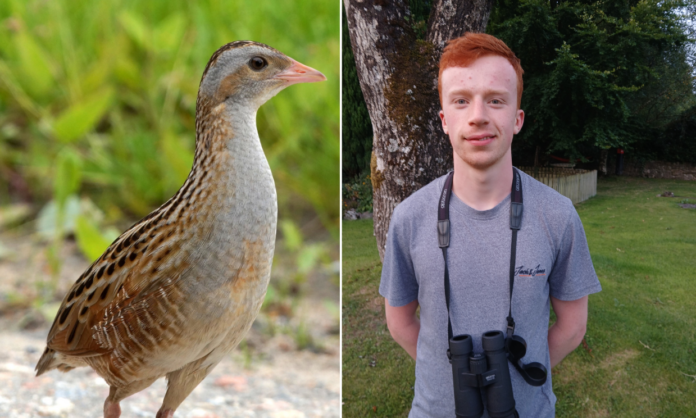The call of the corncrake is an unusual and distinctive one that was once part of the summer sounds heard in rural Ireland from late May until early August. But it’s one that became extinct in rural Westmeath in the past thirty to forty years – so much so that when the sound was heard close to the Royal Canal west of Mullingar in early August, it went unrecognised at first.
Members of a family who went fishing on the Bank Holiday weekend evening on the Canal not far from Coolnahay Harbour were startled by a strange sound – one they’d never heard before – coming from a marshy area of grassland nearby. The two-syllable “scraping” sound kept kept being repeated, and afterwards, the angler’s mother googled bird sounds, and sent an e-mail to the Birdwatch Ireland site, and was able to confirm that it was a corncrake’s call.
“I was contacted by a person from the West of Ireland involved in the Corncrake preservation scheme, and he thought I could have heard a bird prior to their migration back to Africa,” she told Topic. “I have no doubts that what I heard was a corncrake.”
Since then, several other people living in the same area also heard what seems to be the same corncrake, helping to confirm the fact that the bird had made its presence felt near Coolnahay – the first heard in Westmeath for decades. One local resident actually suggested that there seemed to be two corncrakes in the area, having heard the call in two different locations, in overgrown areas east and west of Coolnahay Bridge.
Corncrakes are most commonly heard from dusk onwards, and the male bird’s loud call often continues for hours at night, but the secretive birds are seldom seen, staying in thick cover. Corncrakes feed mainly on slugs, snails, insects and worms and at this time of year on seeds of grasses and sedges also, prior to their 6,000 km “departure flight” to the Congo area of west Africa in September.
Before mechanised farming practices took over when saving hay was the norm rather than silage production, the summer sound of the corncrake’s call was common across most counties after the birds arrived in Ireland each year. But once the most common nesting sites of corncrakes in hayfields no longer existed, the drastic decline in corncrake numbers began with the grassland habitats for hatching eliminated.
The story was the same in other countries, and corncrakes were seen as facing extinction. In Ireland, only small numbers survived, little more than 100 pairs, mostly in remote areas of north Donegal and western parts of Mayo and Galway. In the past few years, thanks to major conservation efforts since 2021, with EU funding for a 5-year Corncrake Traonach project, the numbers of breeding pairs recorded has risen by one third, and exceeded 200 pairs last year for the first time in decades, but this is still a tiny number. The Irish project has involved more than 250 farmers and landowners and 1500 hectares of land, and when any additional nesting areas are identified, special efforts are made to encourage and protect the birds.
When Topic spoke to Michael Wycherley, PRO with Birdwatch Ireland Westmeath Branch, he confirmed that the presence of a corncrake in the area is highly unusual but potentially exciting event.
“It is quite unlikely that we would get corncrakes here in these parts, they are quite localised in Ireland. Tory Island is a good spot for them, Belmullet is another,” he said.
“However, sometimes on passage, they can stop off in areas for a few days. A few corncrakes might stop off anywhere suitable in Ireland and then continue on their migration.”
“In other areas like Cork in spring and autumn, there are reports of corncrake calls but there are not many bird watchers in Westmeath listening to these things so they could potentially go under the radar. The time doesn’t really fit in with autumn migration as it normally happens around September or October as they return to Africa, but that’s not to say this is absolutely impossible.”
He said he would like to have it confirmed. “I’d like an eyewitness as I don’t get my hopes up as they can get dashed pretty quickly. A lot of birds have very unusual sounds occasionally, for example, and some can parrot the sounds they hear. One bird that’s a very good mimic in Ireland is the starling, I’ve heard starlings sounding exactly like buzzards.”
Westmeath is underrated for biodiversity according to the birdwatcher, who pointed out the great range of water birds and ducks on our lakes.
Birdwatch Ireland Westmeath branch meet at Áras an Mhuilinn on the second Tuesday of every month, returning in September following their summer break.















